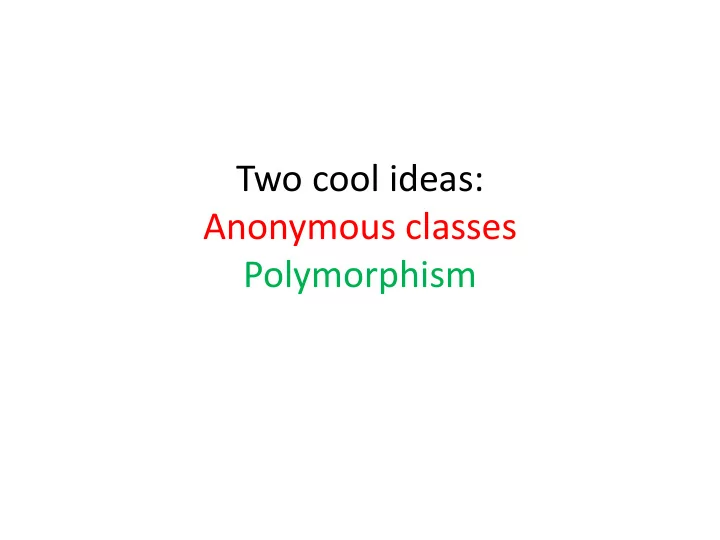

Two cool ideas: Anonymous classes Polymorphism
Anonymous classes – motivation • You probably have many buttons and/or menu items in your VectorGraphics project • Three approaches for responding to the events from selecting those buttons / menu items 1. Classic: Each button is a class that implements ActionListener 2. Least code: Panel responds to ALL buttons 3. Anonymous class for each button
Anonymous classes – motivation 1. Classic: Each button (likewise for menu-item) is a class that implements ActionListener • Obeys Quality Tip: Buttons should respond to themselves public class XXXButton extends JButton implements ActionListener { public XXXButton(XXPanel panel) { // store panel in field } public void actionPerformed(ActionEvent event) { // Ask panel to ... }
Anonymous classes – motivation 2. Panel responds to ALL the buttons and menu-items • Not very OO, but easy to code Or this if this code is in the Panel class Wherever buttons are constructed: button.addActionListener(panel); public class XXXPanel extends JPanel implements ActionListener { public void actionPerformed(ActionEvent event) { JButton button = (JButton) (event.getSource()); if (button.getText ().equals(“Make rectangle”) { // construct and draw a rectangle } else if (...) { // etc } // etc } }
Anonymous classes 3. Button responds via an anonymous class • Responding code is physically close to constructing code • Code in red below is the anonymous class Wherever buttons are constructed: button.addActionListener(new ActionListener() { public void actionPerformed(ActionEvent event) { // Ask panel to ... } }); The anonymous class is an inner class and hence can refer to: • Any field of the enclosing class • Any local variable in the enclosing method if the variable is final .
Polymorphism • You probably have a list of objects that paintComponent draws: ArrayList<MyShape> objectsToDraw; • Suppose MyShape is an interface that specifies a draw method that takes a Graphics object. Then paintComponent(Graphics g) can be: for (MyShape objectToDraw : objectsToDraw) { objectToDraw.draw(g); } • At run time, each objectToDraw morphs into the particular type it actually is, and uses its actual draw method. • Bottom-line: for any statement like x.foo(…); the actual type of x (not the declared type) is what determines which foo function to run
Recommend
More recommend